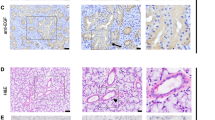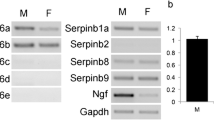Abstract
The submandibular gland (SMG) of mice shows a marked sexual dimorphism in which a duct portion called the granular convoluted tubule (GCT) is developed preferentially in males during puberty. The administration of testosterone to female mice causes the conversion of striated duct (SD) cells into GCT cells, but the underlying molecular mechanisms are unclear. Cyclic AMP response element-binding protein (CREB) is a transcription factor functioning downstream of a variety of signal transduction pathways. In the present study, we examined the expression, activation and cellular localization of CREB in the mouse SMG using Western blotting and immunohistochemistry. Both total CREB (t-CREB) and phosphorylated CREB (p-CREB) were significantly more abundant in the female than in the male gland and were localized to the nuclei of intercalated duct cells and a subpopulation of SD cells. In contrast, the GCT cells in males were negative for t- and p-CREB. The levels of CREB in the SMG were increased by castration in males and decreased by repeated administration of testosterone to females or castrated males. From 3 h after a single administration of testosterone to females, many SD cells temporarily gained nuclear immunoreactivity for both t- and p-CREB, which was lost as the cells were converted to GCT cells by 24 h. These results suggest the involvement of CREB in the androgen-dependent differentiation of the duct system in the mouse SMG.








Similar content being viewed by others
References
Amano O, Iseki S (1998) Occurrence and nuclear localization of cAMP response element-binding protein in the postnatal development of the rat submandibular gland. Histochem J 30:591–601
Barka T (1980) Biologically active polypeptides in submandibular glands. J Histochem Cytochem 28:836–859
Caramia F (1966a) Ultrastructure of the mouse submaxillary gland. I. Sexual differences. J Ultrastruct Res 16:333–345
Caramia F (1966b) Ultrastructure of the mouse submaxillary gland. II. Effect of castration in the male. J Ultrastruct Res 16:505–523
Chang C, Salzman A, Yeh S, Young W, Keller E, Lee HJ, Wang C, Mizokami A (1995) Androgen receptor: an overview. Crit Rev Eukar Gene Expr 5:97–125
Cheng J, Watkins SC, Walker WH (2007) Testosterone activates mitogen-activated protein kinase via Src kinase and the epidermal growth factor receptor in Sertoli cells. Endocrinology 148:2066–2074
Chretien M (1977) Action of testosterone on the differentiation and secretory activity of a target organ: the submaxillary gland of the mouse. Int Rev Cytol 50:333–396
Cutler LS, Chaundhry AP (1975) Cytodifferentiation of striated duct cells and secretory cells of the convoluted granular tubules of the rat submandibular gland. Am J Anat 143:201–218
Denny PC, Chai Y, Klauser DK, Denny PA (1993) Parenchymal cell proliferation and mechanisms for maintenance of granular duct and acinar cell populations in adult male mouse submandibular gland. Anat Rec 235:475–485
Denny PC, Liu P, Denny PA (1999) Evidence of a phenotypically determined ductal cell lineage in mouse salivary glands. Anat Rec 256:84–90
Fix C, Jordan C, Cano P, Walker WH (2004) Testosterone activates mitogen-activated protein kinase and the cAMP response element binding protein transcription factor in Sertoli cells. Proc Natl Acad Sci USA 101:10919–10924
Foradori CD, Weiser MJ, Handa RJ (2008) Non-genomic actions of androgens. Front Neuroendocrinol 29:169–181
Gresik EW (1980) Postnatal development changes in submandibular glands of rats and mice. J Histochem Cytochem 28:860–870
Gresik EW (1994) The granular convoluted tubule (GCT) cell of rodent submandibular gland. Microsc Res Technol 27:1–24
Gubits RM, Shaw PA, Gresik EW, Onetti-Muda A, Barka T (1986) Epidermal growth factor gene expression is regulated differently in mouse kidney and submandibular gland. Endocrinology 119:1382–1387
Heinlein CA, Chang C (2002) The roles of androgen receptors and androgen-binding proteins in nongenomic androgen actions. Mol Endocrinol 16:2181–2187
Hipkaeo W, Wakayama T, Yamamoto M, Iseki S (2004) Expression and localization of the transcription factor JunD in the duct system of mouse submandibular gland. J Histochem Cytochem 52:479–490
Hipkaeo W, Sakulsak N, Wakayama T, Yamamoto M, Nakaya M, Keattikunpairoj S, Kurobo M, Iseki S (2008) Coexpression of menin and JunD during the duct cell differentiation in mouse submandibular gland. Tohoku J Exp Med 214:23–245
Jacoby F, Leeson C (1959) The postnatal development of the rat submaxillary gland. J Anat 93:201–206
Johannessen M, Moens U (2007) Multisite phosphorylation of the cAMP response element-binding protein (CREB) by a diversity of protein kinases. Front Biosci 12:1814–1832
Johannessen M, Delghandi MP, Moens U (2004) What turns CREB on? Cell Signal 16:1211–1227
Kim J-G, Amano O, Wakayama T, Takahagi H, Iseki S (2001) The role of cyclic AMP response element-binding protein in testosterone-induced differentiation of granular convoluted tubule cells in the rat submandibular gland. Arch Oral Biol 46:495–507
Losel RM, Falkenstein E, Feuring M, Schultz A, Tillmann HC, Rossol-Haseroth K, Wehling M (2003) Nongenomic steroid action: controversies, questions, and answers. Physiol Rev 83:965–1016
Michels G, Hoppe UC (2008) Rapid actions of androgens. Front Neuroendocrinol 29:182–198
Morrell JI, Gresik EW, Barka T (1987) Autoradiographic localization of dihydrotestosterone binding in the major salivary glands and other androgen-responsive organs of the mouse. J Histochem Cytochem 35:1053–1058
Pinkstaff CA (1980) The cytology of salivary glands. Int Rev Cytol 63:141–161
Sar M, Lubahn DB, French FS, Wilson EM (1990) Immunohistochemiccal localization of the androgen receptor in rat and human tissues. Endocrinology 127:3180–3186
Schmidt BMW, Gerdes D, Feuring M, Falkenstein E, Christ M, Wehling M (2000) Rapid, nongenomic steroid actions: a new age? Front Neuroendocrinol 21:57–94
Shaywitz AJ, Greenberg ME (1999) CREB: a stimulus-induced transcription factor activated by a diverse array of extracellular signals. Annu Rev Biochem 68:821–861
Srinivasan R, Chang WWL (1975) The development of the granular convoluted duct in the rat submandibular gland. Anat Rec 182:29–40
Walker WH, Fucci L, Habener JF (1995) Expression of the gene encoding transcription factor adenosine 3′, 5′-monophosphate (cAMP) response element-binding protein: regulation by follicle-stimulating hormone-induced cAMP signaling in primary rat Sertoli cells. Endocrinology 136:3534–3545
Wehling M (1997) Specific, nongenomic actions of steroid hormones. Annu Rev Physiol 59:365–393
Zajicek G, Yagil C, Michaeli Y (1985) The streaming submandibular gland. Anat Rec 213:150–158
Zhou Z-X, Wong C-I, Sar M, Wilson EM (1994) The androgen receptor: an overview. Rec Prog Horm Res 49:249–274
Acknowledgments
This work was supported by a Grant-in-Aid for Scientific Research from the Ministry of Education, Science and Culture of Japan to SI. We thank S.Yamazaki for technical assistance.
Author information
Authors and Affiliations
Corresponding author
Rights and permissions
About this article
Cite this article
Keattikunpairoj, S., Wakayama, T., Yamamoto, M. et al. Expression of cAMP response element-binding protein in the duct system of the mouse submandibular gland. Histochem Cell Biol 132, 647–657 (2009). https://doi.org/10.1007/s00418-009-0649-2
Accepted:
Published:
Issue Date:
DOI: https://doi.org/10.1007/s00418-009-0649-2




